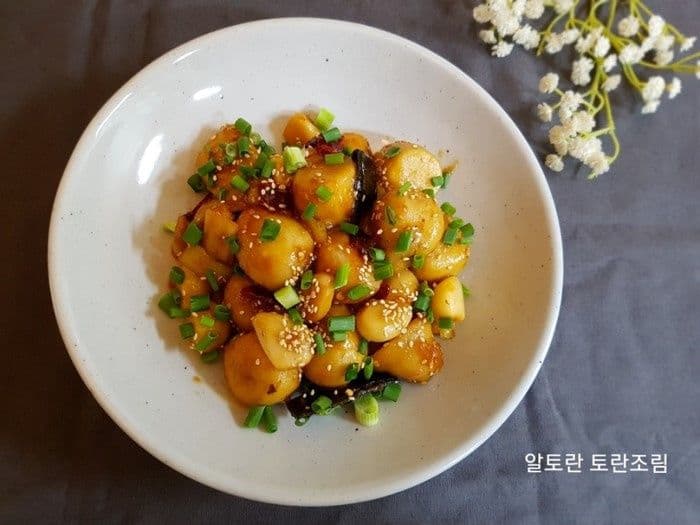This Root Looks Like a Potato, But the More You Eat It, the Better Your Digestion Gets

A Humble Root with Extraordinary Powers
Have you ever encountered a vegetable that actually helps digestion the more you eat it? Meet taro root, known as toran in Korea. This fuzzy brown root may look unremarkable next to its flashy cousin the sweet potato, but dont let appearances fool you. When autumn arrives in Korea from late summer through early fall, taro takes center stage in home kitchens across the country, transforming into a beloved side dish called toran jorim, or braised taro.
The Korean name toran literally means earth eggs, a poetic reference to how these oval roots nestle underground like hidden treasures. Unlike regular potatoes, taro has a distinctive chewy yet tender texture that becomes incredibly soft when slow-cooked in sweet-salty soy sauce. Food bloggers and home cooks on platforms like Naver and Tistory consistently praise this dish for its ability to stimulate appetite during hot weather when people typically eat less. The glossy coating of soy-based glaze, enriched with sesame oil and rice syrup, creates an irresistible sheen that makes your mouth water just looking at it.
What makes taro truly special is its nutritional profile. This root vegetable contains resistant starch and abundant dietary fiber, making it surprisingly easy to digest despite being a starchy food. Traditional Korean cooking wisdom has long recognized taro as a stomach-friendly ingredient, perfect for those recovering from illness or dealing with digestive troubles.
The Secret Ingredient Your Stomach Will Thank You For

Wondering what makes taro so gentle on your digestive system? The answer lies in a remarkable compound called mucin, the same slippery substance that gives taro its characteristic slick texture. When you handle raw taro, you might notice it feels slightly slimy, almost like okra. This isnt a flaw but rather a feature that makes taro incredibly beneficial for gastrointestinal health.
Mucin acts as a protective coating for your stomach lining, shielding it from harsh stomach acid and reducing irritation. Recent studies highlighted in Korean health publications note that this mucilaginous component helps people suffering from acid reflux, gastritis, and stomach ulcers. The fiber content in taro is equally impressive, with more than double the amount found in regular potatoes. This fiber promotes healthy bowel movements and serves as food for beneficial gut bacteria, creating an optimal environment for digestive wellness.
As an alkaline food, taro helps neutralize excess acidity in the body caused by consuming too much meat, processed foods, or sodium-heavy meals. This makes it an ideal complement to the Korean diet, which often features grilled meats and fermented foods. Beyond digestion, taro delivers essential nutrients including potassium for blood pressure regulation, vitamin C for immune support, and manganese for bone health. Korean wellness blogs frequently recommend taro for people trying to maintain a balanced diet during seasonal transitions, when bodies need extra nutritional support.
Mastering the Art of Korean Braised Taro
Creating the perfect toran jorim requires understanding a few key techniques that Korean home cooks have refined over generations. The first critical step is properly preparing raw taro to remove its natural toxicity and reduce the tingling sensation it can cause on your hands and throat. Korean recipe sites universally recommend boiling peeled taro in salted water or rice-rinsing water for 5 to 15 minutes before proceeding with the braising process.
The braising sauce is where the magic happens. A classic recipe from cooking show Choi Yobi features a mixture of soy sauce, rice wine, corn syrup or rice syrup, and water, creating that signature sweet-savory balance Koreans call danjjan. Many cooks add kombu seaweed to the braising liquid early on, allowing its natural umami to infuse the sauce before adding aromatics like whole garlic cloves, white parts of scallions, and dried red chili peppers. One popular tip from blogger Kim Hajin suggests coating the parboiled taro in oil before braising, which prevents the pieces from sticking to the pot and helps maintain their shape.
The cooking process itself is meditative, as you watch the braising liquid slowly reduce while the taro absorbs the savory-sweet flavors. Community reactions on Korean food forums like Naver Blog show that people particularly appreciate how the sauce becomes more concentrated over time, with some noting that leftover toran jorim tastes even better the next day after the seasonings have fully penetrated the roots. Finishing touches include a drizzle of sesame oil for nuttiness and a sprinkle of sesame seeds for visual appeal and added texture.
Storage Tips and Cultural Significance
One of toran jorims practical advantages is its excellent storage capability, making it a favorite make-ahead side dish for busy Korean households. After cooking, the key is allowing the dish to cool completely before transferring it to an airtight container. Korean food preservation guides emphasize this step because sealing warm food creates condensation that can spoil the dish quickly. Properly stored in the refrigerator, braised taro stays fresh for 4 to 5 days, with the flavors actually deepening as time passes.
For longer storage, toran jorim freezes beautifully for 2 to 3 weeks when portioned into individual servings using freezer bags or containers. Before eating frozen portions, thaw them in the refrigerator overnight, then reheat in a pan with a touch of sesame oil to restore the original glossy texture and aromatic fragrance. Some creative cooks mentioned on Korean recipe platforms repurpose intensely flavored leftover toran jorim by stir-frying it with blanched vegetables or tofu, creating an entirely new dish.
Beyond its practical kitchen applications, taro holds cultural significance in Korean foodways. During Chuseok, the autumn harvest festival, families traditionally prepare toran guk, a beef and taro soup that celebrates the seasons bounty. The appearance of fresh taro in markets signals the arrival of autumn just as surely as changing leaves. For international readers exploring Korean cuisine, toran jorim offers an accessible entry point into understanding how Korean cooking balances health consciousness with deep, satisfying flavors. This humble earth egg demonstrates that the best ingredients often hide beneath unpromising exteriors, waiting to reveal their true value through patient preparation and thoughtful cooking.
Discover More

Late-Night Fire at Incheon Yeonan Pier Shopping Complex - No Casualties Reported
A fire broke out at a commercial building near Incheon's popular Yeonan Pier on July 24, 2025. While the 3-story structure's first floor was severely damaged, swift response from 60 firefighters prevented casualties in this bustling seafood market district.

Peace Talks End, Missiles Launch: The Endless Cycle of Russia-Ukraine War
Hours after the third Istanbul peace talks wrapped up with minimal progress, Russia and Ukraine exchanged deadly drone strikes, with attacks hitting Sochi's oil facilities and Ukrainian cities. The war shows no signs of ending despite ongoing diplomatic efforts.